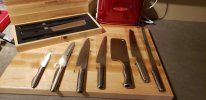Here you go.
https://www.bladeforums.com/threads/i-tested-the-edge-retention-of-48-steels.1726279/ 
I'm one of those who doesn't base a purchase on the blade steel. In all honesty, blade steel is the last thing I am concerned about, at least 99.999999982% of the time.
Really, the only time I even consider blade steel is if I'm looking for a "woods" knife. In which case, I want a plain old time proven carbon steel, or
possibly 440A/420HC.
No super/ultra hard 60 plus Rockwell "super steels" need apply.
If the edge rolls, I can fix that in a couple minutes using just the leather upper of my boot, or my belt, or worse case, my porcelain on steel coffee cup.
If the edge chips or the blade breaks, I can't fix that in the field ... a knife with a chipped blade is worse than useless to me. By definition, a knife with a broken blade is unusable and hence worthless, regardless of what the blade steel is.
Usually when I'm afield/I was afield, I'm not/I wasn't in a position (or location) where I can/could just pop on over to the nearest Walmart/Target/Kmart/Blaine's Tractor Supply/Hardware/Sears or sporting goods store to replace a knife - or anything else - even if I have/had the required funds available.
My current woods/hunting knife? Choice of MoraKniv Number 1 with "Carbone" blade; Western L66 (1095 blade); Buck 110 and/or 877 (420HC) Old Timer 7OT with 1095 or "Schrade +" (I have both), Old Timer 6OT with "Schrade +" blade, and a 1800's style Russell Green River Sheath Knife with 1095 blade... oh and a older Cold Steel Finn Bear, with I believe a 1.4116 blade.

Honestly, I don't think I
need another woods/hunting knife in this lifetime ... though I
would like a Russell Green River, or Old Hickory "Buffalo Skinner"....



